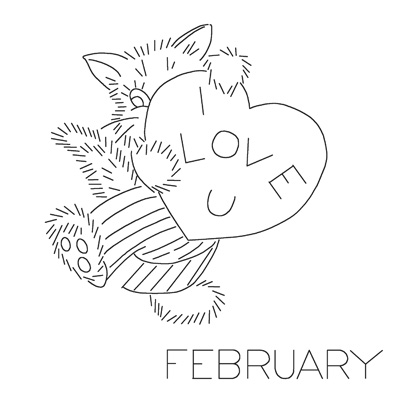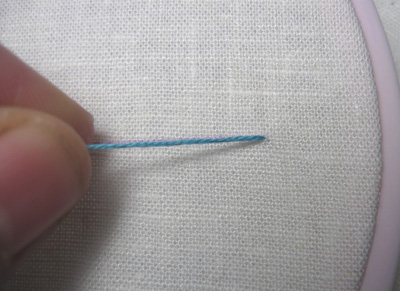In embroidery, couching is a technique for attaching a length of thread to a base fabric by taking tiny stitches over it at regular intervals. The word couch comes from the French verb "coucher" which means to lay down, so it really applies to attaching just about anything (embroidery floss, thin cord, wool, or even ribbon) as long as it uses stitches over or on top. You can couch a length of ribbon with a row of French knots running down the center or by laying a row of herringbone stitches over the top. I'm going to talk about the traditional embroidery stitch today but don't be afraid to think outside the box and use the technique for attaching other things besides thread.
Couching looks really pretty when worked in two colors and is a nice alternative for working outlines, especially ones that form loops and have lots of curves. I discovered a few examples where it's used this way in my linen stash. The first is from a runner with embroidered flower bouquets and ribbons and each of those ribbons is done with couching—the base thread is dark blue and the couching stitches are pink.
In the second example it's used as a substitute for outline stitch and is done with black stitches over blue.
This is a super easy stitch. Bring your base or foundation thread to the front and lay it on the fabric. I worked a straight line but you can use it for curves as well. In fact, it works very well as a freeform technique if you don't quite know where you're going.
Now bring your couching thread to the front just above the thread you’ve laid down.
Take a tiny stitch over the base thread and pull the thread through to the back.
Bring your needle up a short distance from the first stitch and repeat.
Here’s what it looks like finished—
And here are some examples using different foundations. The middle one uses several strands of needlepoint wool and the bottom one uses thin satin ribbon.
I mentioned earlier that you can attach just about anything this way. Artist Megan Jeffery uses couching to attach wool yarn with embroidery thread to felt—and you can see some examples of her work
here and
here. And embroidery artist Debra Spincic has some beautiful
pictures of her work on Flickr, many of which involve couching with ribbon and alternate stitches over the top. Be sure to follow her photostream to see lots of examples of the stitches we've already learned.




























